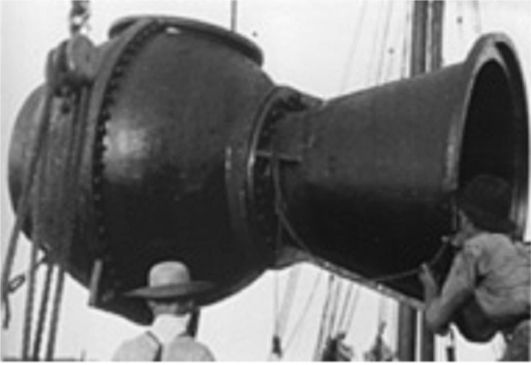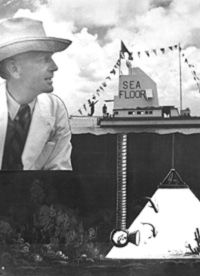|
At the bottom of this arm an enclosed space was created that facilitated
divers in performing salvage attempts. His original patent of 1903
shows multiple arms and helmets mounted on the underwater chamber.
This way the diver could look at the sea bottom and handle the
objects of salvaging at the same time.
The work of Captain Williamson led to the founding of the "Williamson
Submarine Corporation" that performed salvaging on the Ward line
steamer 'Marida'. The attempts to salvage the silver aboard this
ship were not very successful.
The divers went down a ladder through the tube to the chamber below. The
tube had a constant feed of fresh air that got pumped in. The
attempt to salvage the silver of the Merida took three weeks.
However, due to problems with the weather, the project was laid to
rest.
In 1917 a second attempt was taken, which failed also.
Further attempts to recover the treasure in 1921 and 1924 were
unsuccessful as well.
In the ongoing years many fruitless attempts were taken.
Even up to 1972 many attempts were undertaken to bring home the treasure.
The costs for such an expedition are estimated to be about a million
dollars. The value of the treasure itself has risen to a cool
thirteen million dollars.
In 1912 John Ernest Williamson (J.E.) had the epiphany that the tube his
father had invented could be put to use to film underwater. He
constructed a special chamber where the cameras were installed. This
chamber is still today called "Williamson Photosphere". |
||
| scroll down for pictures | ||
| translation made with thanks to Mr. A. Scheijde | ||
| Charles Williamson was de vader van John Ernest Williamson (1881-1966) een belangrijke cineast die de eerste onderwater films maakte. Kapitein Charles Williamson was de uitvinder van een flexibele arm met een gekoppelde want. Deze flexibele arm leidde tot de ontwikkeling van een buis die vanuit een boot te water werd gelaten naar de zeebodem. | ||
|
Onderaan deze arm werd een kamer aangebracht die de duikers in staat stelden bergingswerk uit te voeren. In zijn oorspronkelijke patent van 1903 was de kamer voorzien van meerdere armen en op de kamer gemonteerde helmen om de duiker in staat te stellen naar de zeebodem te kijken en met de armen bergingswerk te verrichten. |
||
|
Het werk van kapitein Williamson leidde tot de oprichting van de “Williamson Submarine Corporation”die onder meer bergingspogingen ondernam op de Ward Liner Merida. De pogingen om het zilver dat aan boord van dit schip aanwezig was waren niet erg succesvol. |
||
|
De duikers daalden via een ladder af door de buis naar de kamer. De buis werd constant voorzien van lucht die middels een pomp in de buis werd geblazen. De poging om het zilver van de Merida te bergen duurde drie weken, echter door problemen met het weer werd het project gestopt.(1911). |
||
|
In 1917 werd een tweede poging ondernomen die
helaas ook mislukte. Ook in 1921 en 1924 mislukte verdere pogingen
de schat te bergen. In de daarop volgende jaren werden nog vele pogingen ondernomen echter allen zonder veel succes. Zelfs tot in 1972 werden vele pogingen
ondernomen de schat te bergen. De kosten voor deze expeditie worden
geschat op 1 miljoen dollar. De waarde van de zilverschat is
inmiddels gestegen tot 13 miljoen dollar. In 1912 realiseerde John Ernest Williamson (J.E.) dat de buis uitgevonden door zijn vader ook te gebruiken was als onderwaterhuis voor filmopnamen. Hij construeerde een speciale kamer waarin de camera’s werden opgesteld. Deze kamer wordt nu “Williamson Photosphere”genoemd. |
||
 |
||
|
With his brother George J.E. took the new Photosphere to the Bahamas
where light penetrates up to 150 ft. (50 meter), which they made it
possible to create the first underwater films. The first film that
was made was called "Thirty leagues under the sea" and was first
showed to an audience in 1914. His equipment made possible the
shooting of the first undersea fiction movie, the 1916 film version
of Jules Verne's Twenty Thousand Leagues under the Sea. Both films
caused sensations in London, Chicago, and New York. Subsequently
Williamson divided his energies between fictional features and
documentary films.
Captain Charles Williamson, father of the successful cinematographers
thus became the founder of their success. He patented a series of
patents that were all based on the invention of the flexible arm and
mitten in the period between 1903 and 1912. |
||
|
Met de nieuwe Photosphere ging J.E. samen met
zijn broer George naar de Bahamas waar licht tot op 150 ft (50
meter) doordrong en het mogelijk maakte de eerste onderwaterfilms te
maken. De eerste film die zo werd gemaakt werd Thirty Leagues under
the Sea genoemd en in 1914 voor het eerst aan het publiek getoond. His equipment made possible
the shooting of the first undersea fiction movie, the 1916 film
version of Jules Verne's
Twenty Thousand Leagues under the Sea. Both films caused
sensations in London, Chicago, and New York. Subsequently Williamson
divided his energies between fictional features and documentary
films. Kapitein Charles Williamson, de vader van de succesvolle cineasten was daardoor de grondlegger voor hun succes. Hij patenteerde in de periode tussen 1903 en 1912 een reeks patenten die allen waren gebaseerd op de uitvinding van de flexibele arm en handschoen. |
||
 |
||
| Click for large pdf file. Courtesy The NYv times | ||
 |
||
| Williamsons patents are: | Description: | Date: |
| US 745,469 | apparatus for submarine work | 1903 |
| US 1,009,123 | apparatus for sunken vessels | 1911 |
| US 1,010,558 | flexible arm and mitten | 1911 |
| US 1,010,559 | submarine operating apparatus | 1911 |
| US 1,016,808 | submarine pleasure apparatus | 1912 |
| US 1,017,486 | submarine mining apparatus | 1912 |
| US 1,023,541 | submarine operating apparatus | 1912 |
|
Recently several film institute’s have restored the old films so
this old footage is ready to be showed to audiences once more. |
||
|
Recent zijn door verscheidene filminstituten de oude films van Williamson gerestaureerd waardoor deze oude beelden weer voor het publiek beschikbaar zijn. |
||
 |
||
 |
||
 |
||
| In the book from Simon lake there are references to Williamsons Photosphere | ||
 |
||
| The following pictures are from the book of Williamson "20 years under the sea" 1936 NY | ||
 |
||
 |
||
 |
||
 |
||
 |
||
| check out this webpage: http://www.therebreathersite.nl/Zuurstofrebreathers/Fun/octopussy.htm | ||
 |
||
| January 2009 | ||
| Please sign my Guestbook | ||
| Email: jw.bech@quicknet.nl | ||
Charles Williamson was the father of John Ernest Williamson (1881-1966),
an important cinematographer who made the first underwater films. Captain
Charles Williamson was the inventor of a flexible arm with
a coupled mitten. This
flexible arm led to the development of a tube that could be lowered from a boat
to the sea bottom.
Menu Atmospheric suits
Updates
Speedmenu
Search page
Webshop
Home
GO BACK TO
ATMOSPHERIC
DIVING SUITS.
Mainmenu:
Search this Website
Information about RB
Photo galleries
Historical Information
Links & Downloads
Reviews
Homebuilders
Electronics
Updates, speed menu
Web shop
Reviews SC rebreathers
Reviews CC rebreathers
RB’s through the ages
Inspiration rebreather
Database Oxygen RB’s
Database Semiclosed RB’s
Updates
Speed menu
Search this web
